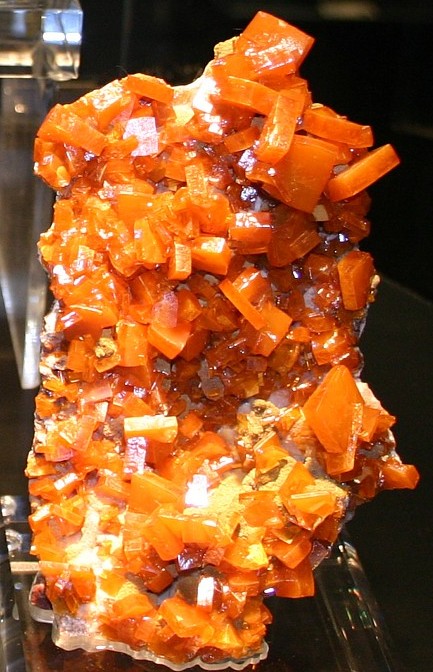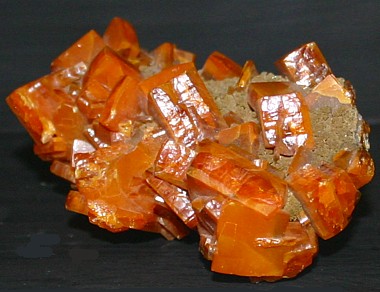|
.
Wulfenite Mineral Facts:
Chemical Formula:
PbMoO4
Lead
Molybdate, contains 39.3% Molybdenum trioxide, and lead oxide 60.7%.
Calcium sometimes replaces a portion of the lead.
Colors:
yellow, orange, red, gray, white.
It has a white streak.
Hardness:
4.5 to 5
Density: 6.8
Cleavage:
Parallel to
the faces of the pyramid, smooth; there is also a less distinct cleavage
parallel to the basal plane.
Crystallography:
Tetragonal
Crystals
usually square tabular in habit with prominent base. Sometimes very thin.
Edges of tables beveled with faces of low second order pyramid. More rarely
pyramidal in habit.
Luster:.
Vitreous to adamantine
luster.
Optics:
(Refractive Index): w = 2.404; e = 2.283;
|
 |
.
|
Composition,
Structure and Associated Minerals:
Wulfenite is a secondary mineral formed from the oxidation of lead
and molybdenum minerals. Together with powellite, they are the only common
natural molybdenates. Wulfenite is found
in the oxidized portion of lead veins with other secondary ores of that
metal, especially minerals like
cerussite,
vanadinite and pyromorphite. Found in the United States in a number of
places in Utah, Nevada, Arizona and New Mexico.
Identification and Diagnostics
Wulfenite is
characterized by by its square, tabular crystals, orange to yellow color,
and high luster. It is distinguished from vanadinite by crystallization, by
a positive test for chlorine (vanadinite) and the test for tungsten. It is
distinguished from Crocoite by a positive test for Molybdenum. If powdered
wulfenite is moistened with concentrated sulfuric acid and evaporated almost
to dryness in a porcelain crucible the residue will show a deep blue color
on cooling (positive test for molybdenum).
Occurrence,
Localities and Origins:
The mineral occurs
in the oxidized zone of veins of lead ores at some of the principal lead
occurrences in Europe, and in the United States near Phoenixville,
Pennsylvania; in the Organ Mountains, New Mexico; at the mines in Yuma
County, Arizona; at the
Red Cloud mine in La
Paz County, Arizona, at
the Mammoth Mine, in Pinal County in the same State, and at many other of
the lead mines in the states of Utah, Nevada, Arizona and New Mexico.
Uses. Well crystallized,
showy specimens of bright colored wulfenite are highly prized as a mineral
specimens. It is also a minor source of molybdenum.
Return to the
Mineral Collectors Information Page |

|
|





